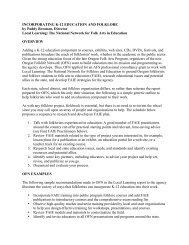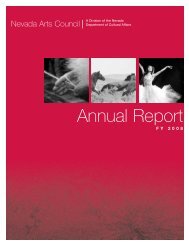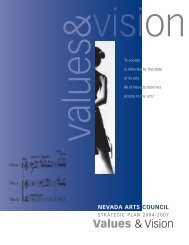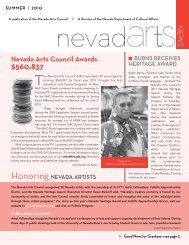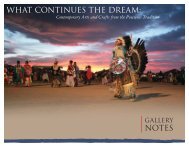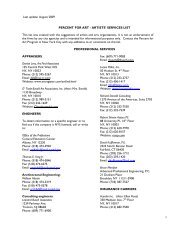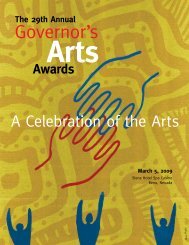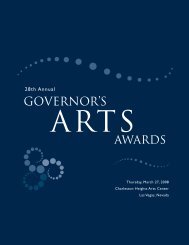Handed Down - Nevada Arts Council
Handed Down - Nevada Arts Council
Handed Down - Nevada Arts Council
Create successful ePaper yourself
Turn your PDF publications into a flip-book with our unique Google optimized e-Paper software.
1995–1996<br />
African Dance:<br />
Malick Sow and Abayomi Goodall<br />
ance and drum is everyday life. What we do<br />
“Devery day, we express it through dance and<br />
drum. If you can walk you can dance, if you can talk you<br />
can sing.” That is how Malick Sow describes the place<br />
of art in his home country of Senegal, in West Africa.<br />
Malick was born in 1950 into a griot family in Dakar.<br />
He describes a griot as a “living book,” learning and<br />
passing on the history of his people through stories and<br />
songs. “Those stories, they come from one generation<br />
to another, from father to son, from grandfather to<br />
grandson. In Africa…we have a big tree we call baobab<br />
where all the elders get together and give the word of<br />
wisdom. It is up to the young generation to operate<br />
those words of wisdom to the community, that’s how<br />
it’s passed down.”<br />
Malick began learning traditional dances and drumming<br />
from his uncle at the age of four, and went on<br />
to form his own dance troupe and later perform with<br />
the National Ballet Company of Senegal. For the last<br />
ten years or so, he has made frequent trips to the U.S.<br />
to perform and teach, which is how he met Abayomi<br />
Goodall, a Las Vegas dance teacher with her own African<br />
dance company. Abayomi has been studying with<br />
various African dance masters for the last 15 years, absorbing<br />
the culture behind the dances as well as the actual<br />
movements.<br />
In African culture, drums are used to communicate,<br />
sending messages between villages, as well as for dances.<br />
The dances also communicate, telling stories with the<br />
body. Both Abayomi and Malick emphasize the importance<br />
of understanding the cultural context of African<br />
music and dance. As Malick says, “It is not about the<br />
drumming and dancing, it is about the knowledge. You<br />
got to know what you’re drumming, you got to know<br />
what you’re dancing, what that means. So that meaning<br />
makes you live it, and when you live it your expression<br />
is moved, your soul lives with it.” Abayomi continues,<br />
“You can’t do African music and dance, you can’t perform<br />
it without knowing the culture of the people. It’s<br />
part of their everyday life. I tell my students, I don’t care<br />
if you never learn a dance movement, I really don’t, if<br />
you learn the history, if you become a better person, if<br />
you get in touch with your ancestors and your culture…<br />
that’s good enough for me.”<br />
Fortunately for the people of Las Vegas, Abayomi<br />
has learned the movements and is generous in sharing<br />
her knowledge and talent. She has formed a group<br />
called the Children of the Diaspora African Musical<br />
Ensemble and is passing on what she learns from<br />
Malick and other African dance masters to the African<br />
American community.<br />
Learning the<br />
stories behind<br />
African dances is<br />
as important as the<br />
steps themselves;<br />
Abayomi Goodall<br />
learns at the feet<br />
of master<br />
Malick Sow.<br />
Abayomi Goodall and<br />
Malick Sow go over the<br />
steps to a West African<br />
dance.<br />
African dance and<br />
drum master Malick Sow<br />
comes from Senegal,<br />
West Africa.<br />
42




